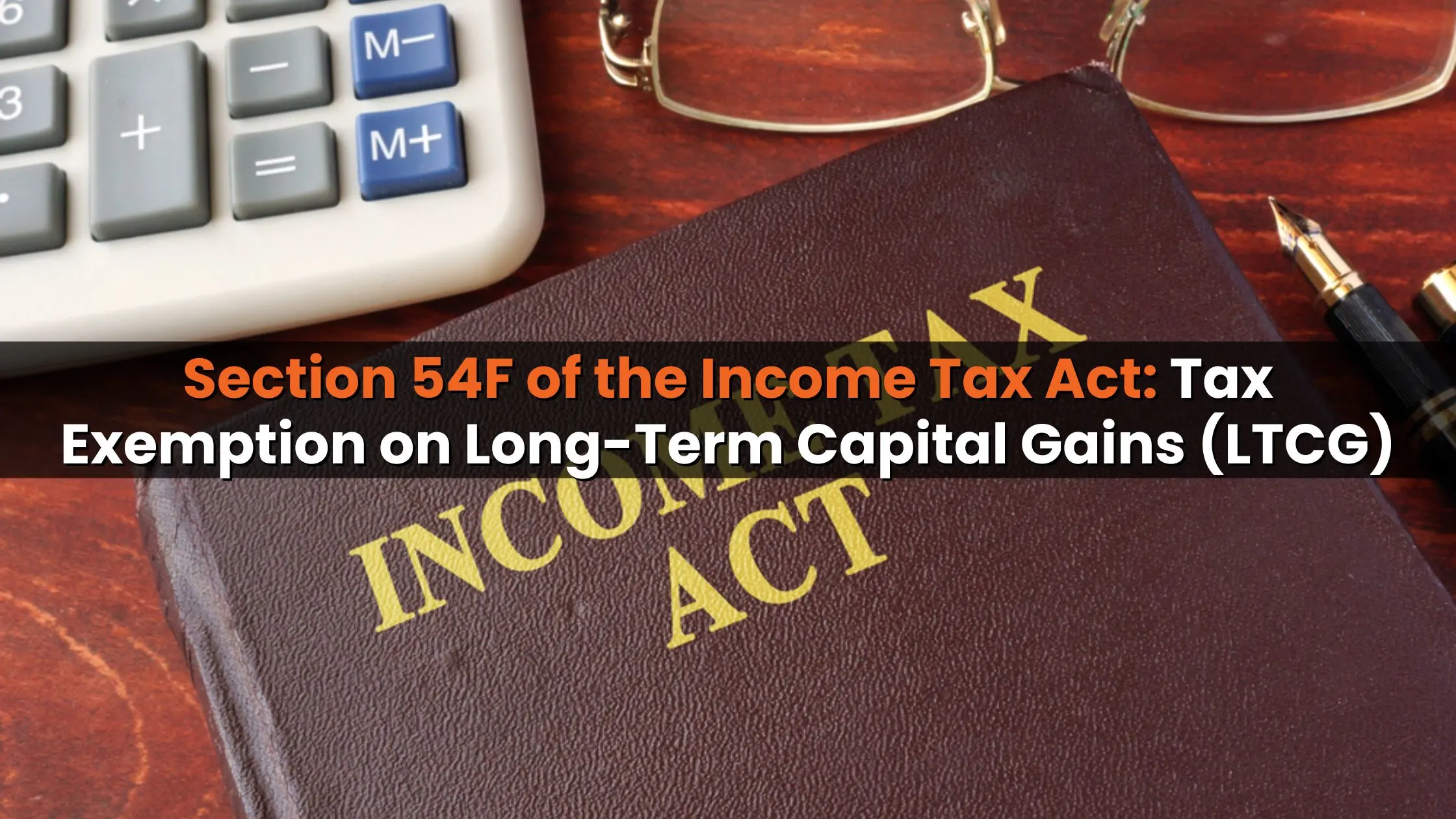Table of Content
- Understanding Section 54F of the Income Tax Act
- Eligibility Criteria and Conditions
- Understanding Net Consideration
- Circumstances Where Section 54F is Not Applicable
- Capital Gain Deposit Account Scheme
- Asset Transfer Implications
- Section 54 vs Section 54F: Key Differences
- Other Tax-Saving Avenues
- Conclusion
The Indian Income Tax Act provides several provisions for taxpayers to reduce their tax liability legally, and one such provision is Section 54F of the Income Tax Act. This section specifically allows individuals and Hindu Undivided Families (HUFs) to claim exemption on long-term capital gains (LTCG) arising from the sale of certain capital assets, excluding residential property. The primary goal of this section is to encourage taxpayers to invest their capital gains into a residential property, thereby availing tax benefits under the law.
Understanding Section 54F of the Income Tax Act
Section 54F of the Income Tax Act applies to long-term capital gains earned from the transfer of any capital asset other than a residential property. Eligible taxpayers include individuals and HUFs who reinvest the proceeds from such sales into a residential property. Assets such as shares, bonds, gold, or other non-house properties qualify under this section, provided the proceeds are used in purchasing or constructing a house. This provision acts as a tax incentive for taxpayers looking to invest in residential real estate while saving on LTCG tax.
Also Read: Waqf Board Portal WAMSI: How It Works, Features, and Full Details
Eligibility Criteria and Conditions
To claim exemption under Section 54F of the Income Tax Act, specific conditions must be met:
- The taxpayer must be an individual or HUF.
- LTCG should arise from selling a non-residential capital asset.
- Investment in a residential property must adhere to timelines:
- Purchase 1 year before the asset sale.
- Purchase within 2 years of the asset sale.
- Construct a residential property within 3 years of the asset sale.
Partial reinvestment results in a partial exemption, while full reinvestment is necessary to claim the entire tax benefit.
Understanding Net Consideration
Net consideration is a critical term under Section 54F of the Income Tax Act. It refers to the total sale proceeds received from transferring the long-term capital asset, minus any expenses incurred in completing the transfer. To claim full exemption, the taxpayer must reinvest the net consideration in a residential property. This ensures that only the actual gains from the asset sale are considered for tax exemption.
Circumstances Where Section 54F is Not Applicable
Exemption under Section 54F of the Income Tax Act may not be claimed in the following scenarios:
- Ownership of more than one residential property at the time of transferring the long-term asset.
- Purchasing another residential property within 1 year of the sale.
- Constructing a residential property in addition to the one purchased under Section 54F within 1 year.
In such cases, the LTCG becomes fully taxable, and the exemption is withdrawn.
Capital Gain Deposit Account Scheme
In situations where taxpayers are unable to immediately utilize the sale proceeds, the Capital Gain Deposit Account Scheme provides a solution. Under this scheme, proceeds can be deposited in a public sector bank, allowing the taxpayer to use the amount partially or fully to purchase or construct a residential property later. This ensures that the benefits under Section 54F of the Income Tax Act are still applicable.
Asset Transfer Implications
After availing the exemption under Section 54F of the Income Tax Act, it is essential to retain the newly purchased or constructed residential property for at least 3 years. Selling or transferring the property within this period results in the withdrawal of the exemption, and the LTCG will be treated as taxable income. Compliance with these rules is critical to maintain tax benefits and avoid penalties.
Section 54 vs Section 54F: Key Differences
While both Section 54 and Section 54F of the Income Tax Act deal with tax exemption on LTCG, they differ in scope:
|
Feature |
Section 54 |
Section 54F |
|
Applicable Asset |
Residential property only |
Any long-term capital asset except residential property |
|
Number of Residential Properties |
No restriction |
Exemption not available if more than one residential property is owned at transfer |
|
Reinvestment Requirement |
Invest in one residential property |
Can invest in one or two residential properties (conditions apply) |
|
Timeline Restrictions |
Purchase/construct within 1–3 years |
Similar, but ownership of other properties affects eligibility |
These differences make Section 54F of the Income Tax Act particularly useful for taxpayers selling non-residential assets and planning to invest in housing.
Also Read: The Ultimate Guide to No Due Certificates: Everything You Need to Know
Other Tax-Saving Avenues
In addition to Section 54F of the Income Tax Act, taxpayers can reduce their tax liability through other provisions:
- Section 80C: Deductions for ELSS, PPF, life insurance, tuition fees, and home loan principal repayment. Maximum deduction: ₹1.5 lakh.
- Section 80D: Health insurance premiums for self, family, and parents, up to ₹25,000 (₹50,000 for senior citizens).
- Section 24(b): Interest paid on home loans, eligible for exemption up to ₹2 lakh.
Combining these measures with Section 54F allows for maximum tax efficiency.
Conclusion
Section 54F of the Income Tax Act is a powerful tool for taxpayers seeking exemption on long-term capital gains from the sale of non-residential assets. By reinvesting proceeds into a residential property and adhering to timelines and conditions, individuals and HUFs can significantly reduce their tax liability. Understanding net consideration, compliance rules, and differences from Section 54 is essential for maximizing benefits. Proper planning and adherence to these provisions ensure that taxpayers can legally save taxes while investing in real estate.











Ans 1. Only individuals and Hindu Undivided Families (HUFs) can claim exemption under Section 54F. Companies, firms, or LLPs are not eligible.
Ans 2. Any long-term capital asset other than a residential property such as land, gold, shares, or bonds qualifies, provided the sale proceeds are reinvested in a residential house.
Ans 3. You can invest in only one residential house in India. Investing in multiple residential properties disqualifies you from claiming the exemption.
Ans 4. If the new property purchased or constructed under Section 54F is sold within 3 years, the exemption is withdrawn, and the previously exempted capital gains become taxable.
Ans 5. Yes. To claim full exemption, the entire net consideration must be reinvested. Partial reinvestment leads to proportionate exemption.
Ans 6. Yes. You can deposit the unutilized sale proceeds into a Capital Gain Deposit Account Scheme (CGDAS) before the due date of filing your income tax return and use it later for purchasing or constructing a house.
Ans 7. Yes, if you have sold two different assets one being a residential property and the other a non-residential one you can claim benefits under both sections separately.
Ans 8. No. The exemption under Section 54F is available only for residential properties located within India.
Ans 9. In such cases, exemption is allowed proportionally, based on the amount reinvested compared to the total net consideration.
Ans 10. Yes, as long as the taxpayer is one of the owners and invests their share of the sale proceeds in the new residential property.